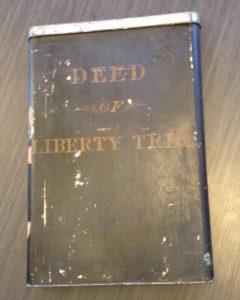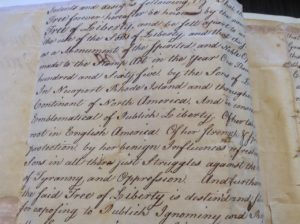
The Liberty Tree’s deed box, from the NHS collections.
This month marks the 250th anniversary of the deeding of Newport’s Liberty Tree and the repeal of the Stamp Act. In 1765, the Sons of Liberty began rallying to protest the Stamp Act on land owned by Captain William Read at the corner of Thames and Farewell Streets.
Newport’s Liberty Tree was probably inspired by Boston’s Liberty Tree, where in 1765 the Sons of Liberty gathered beneath a Boston elm tree to protest the Stamp Act. In 1766, Capt. William Read deeded the plot of land, including a large buttonwood tree that grew there, to William Ellery and Newport’s Sons of Liberty.

The Liberty Tree’s deed, from the NHS collections.
Upon its dedication Read insisted that, “The said tree forever hereafter be known as the Tree of Liberty, and be set apart to and for the use of the Sons of Liberty, and that the same stand as a Monument of the Spirited and Noble Opposition made to the Stamp Act in the year One Thousand seven hundred and Sixty-five, by the Sons of Liberty.”
Word of the Stamp Act’s repeal arrived in Newport in May 1766. There was reportedly much public rejoicing at the news including displaying an 8×14 foot painting of Newport Harbor to highlight “the Advantages which LIBERTY gives to COMMERCE”.
In December 1776, at the start of the three year British occupation, the first Liberty Tree was cut down by British troops. A new tree was planted in 1783 which lasted until the 1860s. A third tree was planted in 1876, but didn’t survive. The current tree was planted in 1897 and appears to have been moved from the original deeded plot of land to the adjacent Ellery Park.
Above: A c.1905 photo of Newport’s Liberty Tree, at the corner of Thames and Farewell Streets, by Clarence Stanhope. From the NHS collection.